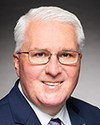Thank you very much.
Thank you, members of the committee. It’s an honour to be here and that everything works today. The last time we sat down and had a meeting, a few days later we were all sent home. I want to thank you all for the work you’ve done over the past few months advocating for veterans and their families.
Mr. Chair, Remembrance Day was yesterday, so I think it's fitting I'm here today talking about how much our veterans mean to us, at a time when we honour those who have served Canada in times of war, military conflict and peace.
Let me first say that over the past eight months, my department has been working to make sure veterans and their families keep receiving the benefits and services they deserve. I have personally spoken with them about how they’re experiencing the pandemic and the supports the department can provide. My message has been that we’re here for them and will always be here for them. The employees of Veterans Affairs Canada have come through in delivering services and financial benefits to veterans and their families while working from home. Veterans are a priority for our government. You’ve heard me say that every time I’ve sat here. That’s because I use every chance I get to make sure that past and present members of Canada’s military know how grateful we are for their service and their sacrifice.
Our government is taking action to make sure Canada’s veterans are well served and well supported. The 2020-21 main estimates and supplementary estimates are an example of that. The $5.4 billion in these estimates represents a 19% increase over the main estimates from last year. That is approximately $800 million more that we’re putting directly into the pockets and well-being of our veterans. It’s money for educational opportunities and career transition services, tax-free benefits for caregivers and services for families. It’s money that will make a big difference in the lives of our veterans and their families. For this reason, we have to do better on service delivery. The backlog is unacceptable. That’s why I made it my top priority when I became Minister of Veterans Affairs and I directed the department to make it its top priority as well. This past June, we introduced a strategy to reduce wait times for veterans. This includes overhauling how teams are organized, making better use of technology and reducing the time it takes to make decisions.
In June, we announced a nearly $200-million investment to address the backlog. This means keeping the 168 adjudicators hired through budget 2018 and hiring an additional 350 employees dedicated to further reducing wait times. According to the Parliamentary Budget Officer’s report, these new hires will have a significant impact on reducing the backlog.
The decision-making process on benefits and programs has been streamlined so less complex cases can move through the system faster, allowing more time to tackle very complex, multi-condition types of claims. It is our top priority and we will not stop until the backlog is under control.
It’s also worth pointing out that earlier this week our government announced $20 million for a veterans organizations emergency support fund. The fund will provide organizations with the resources they need to keep operating and supporting the veterans community as we deal with the ongoing effects of the COVID–19 pandemic.
We’re forever grateful to each and every one of our veterans for their service and sacrifice and will continue to do everything we can to make sure proper support is available to them.
With that, Mr. Chair, I’m pleased to answer any questions.



